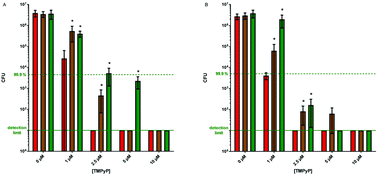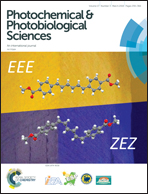Susceptibility of sodA- and sodB-deficient Escherichia coli mutant towards antimicrobial photodynamic inactivation via the type I-mechanism of action
Abstract
Photodynamic antimicrobial chemotherapy (PACT) is a multi-target method to inactivate pathogenic microorganisms by exciting a photosensitizer (PS) with visible light of appropriate wavelength in the presence of molecular oxygen (3O2). There are two major pathways by which reactive oxygen species (ROS) are produced. In type I (TI)-reactions, radicals such as superoxide (O2˙−) and hydroxyl radicals (˙OH) are generated by electron transfer. In type II (TII)-reactions, highly reactive singlet oxygen (1O2) is produced by direct energy transfer. This study investigated the efficiency of PACT in Gram-negative Escherichia coli wild type (EC WT) and the mutant Escherichia coli PN134 (EC PN134) which is not able to produce SOD A and SOD B, by means of two different photosensitizers (PS) from different chemical classes with different 1O2 quantum yields: methylene blue (MB) and 5,10,15,20-tetrakis(1-methyl-4-pyridinio)porphyrin tetra(p-toluenesulfonate) (TMPyP). Mutants, which lack antioxidant enzymes, were particularly susceptible towards TI-PACT. In the case of PACT with MB, quenching agents such as superoxide dismutase (SOD) and catalase (CAT) were sufficient for protecting both the wild type and the mutant, whereas they were not in PACT with TMPyP. The genetic levels of sodA and sodB were examined after photodynamic treatment regarding their potential resistance. This study showed that – under the photodynamic conditions presented in this study – expression of sodA and sodB was not directly influenced by PACT-generated oxidative stress, although SOD enzymes are part of the major defense machinery against oxidative stress and were thus expected to be upregulated. Overall the susceptibility of EC PN134 and EC WT differed towards photodynamic inactivation via TI-mechanism of action. Thus, already existing defense mechanisms against ROS in bacteria might influence the susceptibility against TI-PACT, while this was not the case using TII-photosensitizers.



 Please wait while we load your content...
Please wait while we load your content...